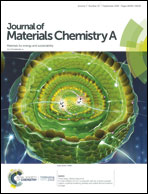Inner space- and architecture-controlled nanoframes for efficient electro-oxidation of liquid fuels†
Abstract
Atomic control of the architecture, composition, and surface of multimetallic nanocrystals enables considerable enhancement of their electrocatalytic performance for renewable energy innovations. Herein, we report a general and facile approach for the synthesis of Pt-based nanoframe (NF) electrocatalysts with tunable inner architecture and surface configuration, which exhibit enhanced activity and durability towards the electro-oxidation of liquid fuels. By judiciously controlling the specific adsorption species and thus the nucleation/growth kinetics, trimetallic PtCuNi NFs with hexapod, octahedral, and concave architectures are obtained. Especially, the concave NFs show the highest specific activities towards methanol and formic acid oxidation reactions, 11.0 and 14.9 times higher than those of benchmark Pt/C, respectively, along with prolonged durability. The combination of CO stripping experiments and density functional theory (DFT) calculation reveals that the enhanced activity is derived from the optimization of defects, d-band centers, and further OH adsorption ability. For the first time, by correlating the inner architecture of NFs with the resulting electrocatalytic performance, we highlight the great potential of structural complexity for further optimization of multimetallic nanoframe electrocatalysts.



 Please wait while we load your content...
Please wait while we load your content...